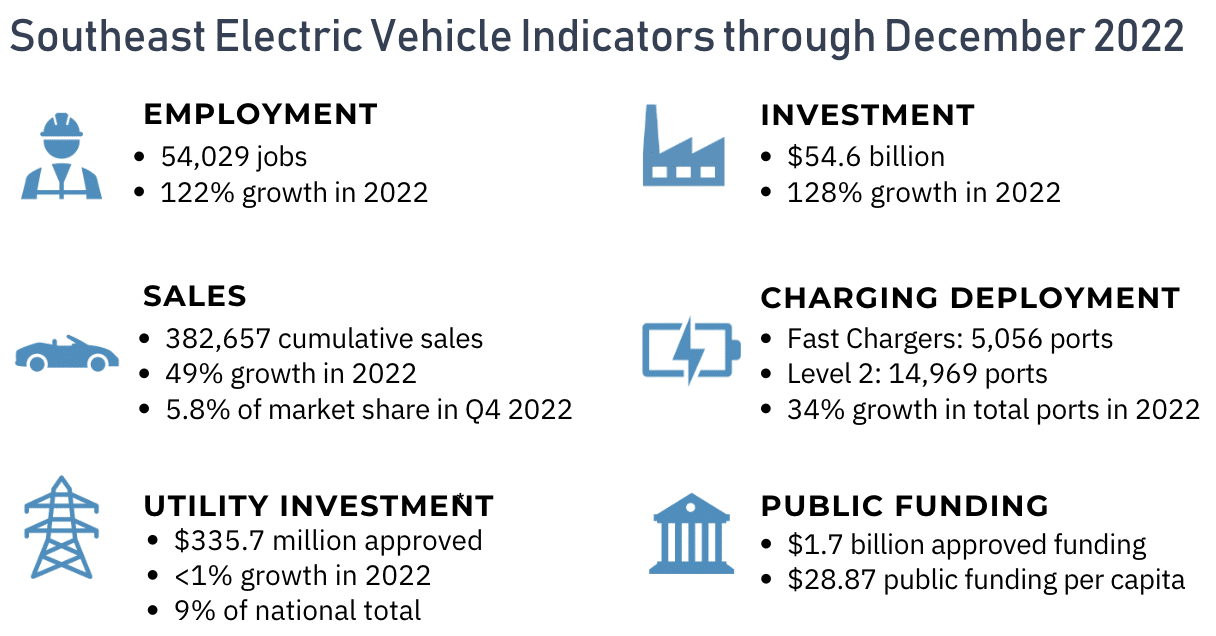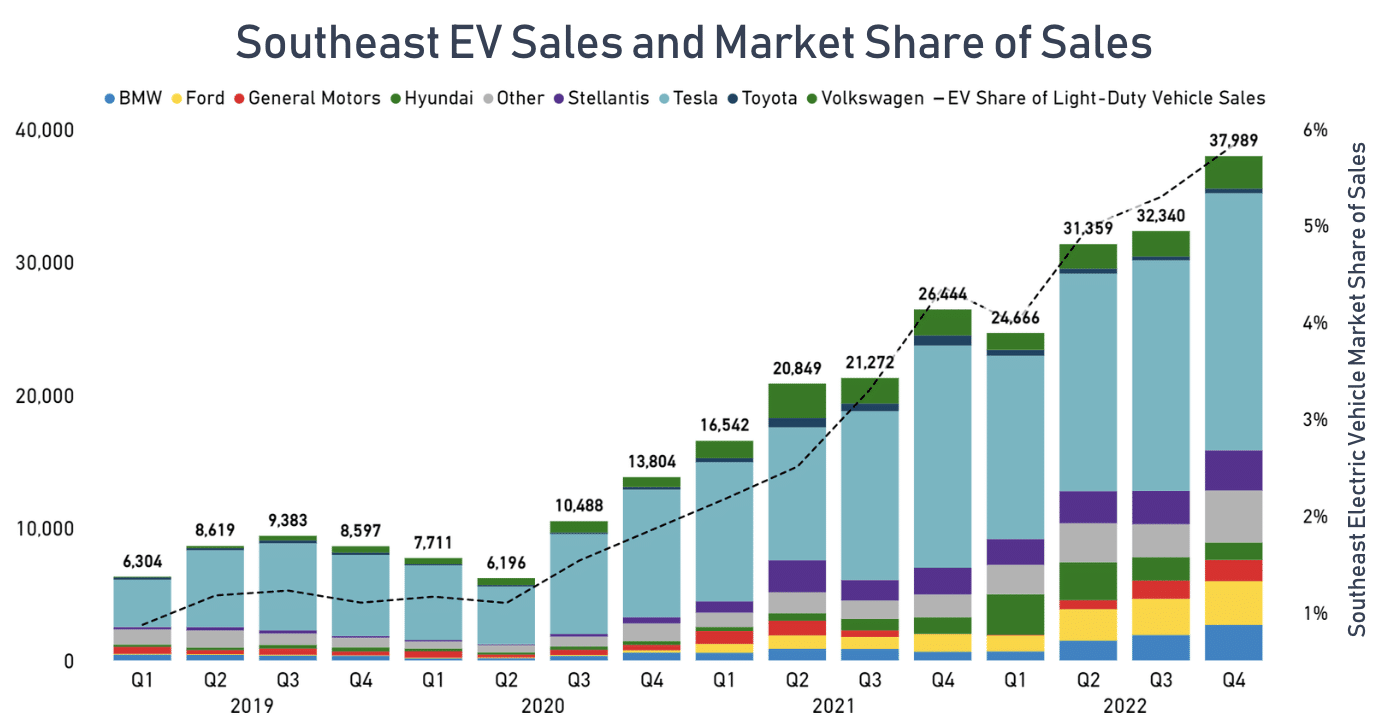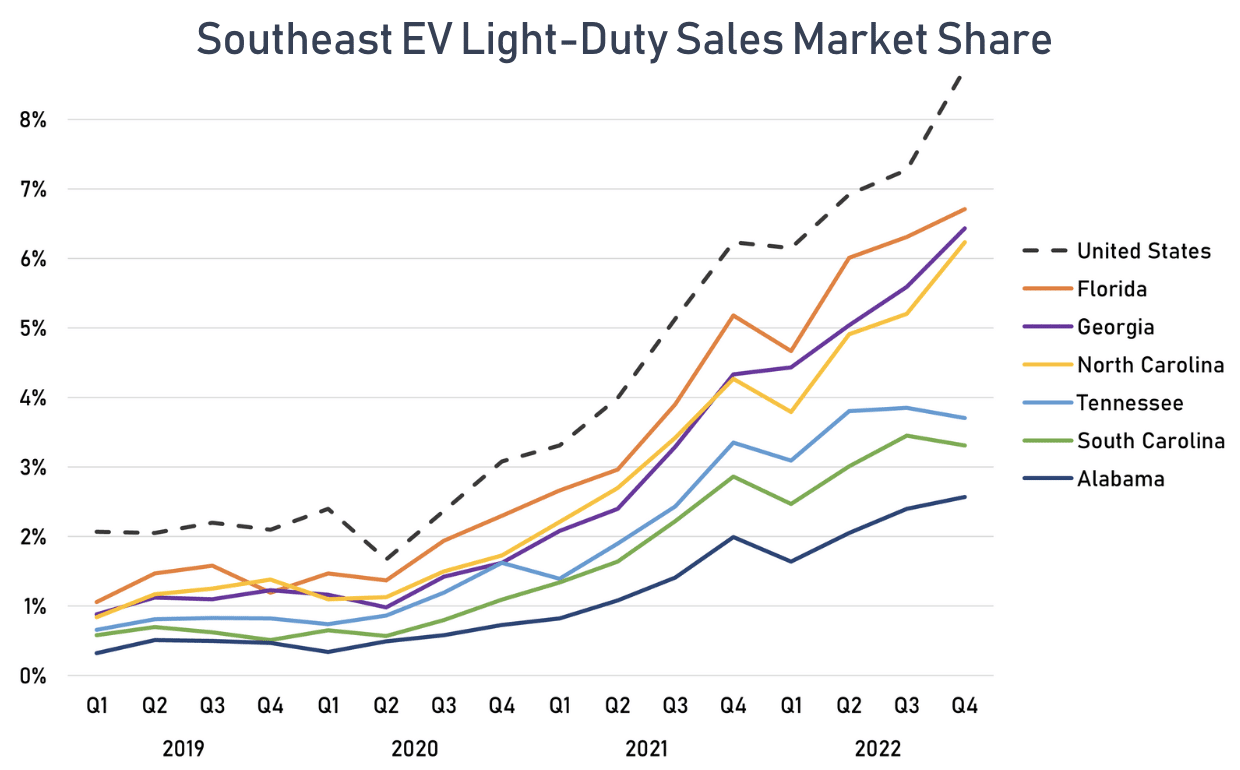In most of the country, the electric buzz is about vehicle sales breaking records as the competition among automakers to deliver desirable and affordable models heats up. But here in the Southeast United States, the biggest quarterly EV market question is not how many EVs were sold – which lately has been a lot – but which state landed the latest multibillion-dollar investment in EV-related manufacturing.
The last two quarters of 2022 were dizzying, with Georgia announcing a series of significant EV manufacturing investments from Hyundai/SK Innovation and FREYR Battery totaling $6.7 billion, North Carolina landing a $5 billion investment from semiconductor company Wolfspeed, South Carolina picking up investments from BMW, battery manufacturer and recycler Redwood Materials, and battery manufacturer Envision AESC totaling $6.3 billion, and Tennessee landing investments from Volkswagen and battery manufacturer LG Chem totaling $4 billion.
Not to be outdone by the investment headlines, EV sales climbed steadily, gaining an impressive 49% growth in 2022 across the region. And many state and local governments are implementing programs, policies, and regulations to knock down barriers to scaling electric car, truck, and bus adoption. Removing market barriers better positions states and local communities for private investment and accessing the massive federal funding streams from the Bipartisan Infrastructure Law and Inflation Reduction Act.
All this regional and state-specific market activity is challenging to track. That’s why the Southern Alliance for Clean Energy (SACE) partners with Atlas Public Policy to publish an annual “Transportation Electrification in the Southeast” report at the end of each second quarter and this handy year-end update to capture data through the end of Q4. This year-end update captures data through December 2022 for six key indicators: employment, investment, sales, charging infrastructure, utility investment, and public funding. The updated data is published in regional and state-specific one-pagers linked below.
[button color=”blue” url=”https://cleanenergy.org/news-and-resources/transportation-electrification-in-the-southeast-2022-report-state-pages/”]View the Updated State Pages[/button][button color=”blue” url=”https://cleanenergy.org/wp-content/uploads/Transportation-Electrification-in-the-Southeast-2022-Report.pdf”]Read the September 2022 Report[/button]
The Regional EV Market

2022 saw staggering regional EV-related employment and investment growth across light, medium, and heavy-duty manufacturing and supply chains, including a more than doubling of expected EV jobs. Light-duty passenger EV sales and charging station deployment continued the consistently upward trends. The big news here is the EV light-duty market share, which is the percentage of new passenger vehicle sales that are EVs, grew from 4.4% in Q4 2021 to 5.8% in Q4 2022 regionally.


Meanwhile, investor-owned utility investments petered out after a remarkable 2021 that saw a 416% increase. Public funding jumped, driven by the Bipartisan Infrastructure Law programs, including the Clean School Bus Program that awarded over $163 million in rebates for over 400 electric school buses across the region.
Some Movement on State Policies
The Southeast lags behind the nation’s strong EV markets regarding supportive electric car, truck, and bus policies and regulations. As a result, it also lags behind national averages in passenger EV market share and medium and heavy-duty EV deployments. With all the EV-related manufacturing coming to the region, pressure is mounting in state houses to pass legislation that removes barriers and supports the expansion of EV charging infrastructure and EV ownership for consumers and fleet operators, so the products that companies are increasingly making in the Southeast can be purchased and driven by consumers and companies in the Southeast.
Of note, Georgia, North Carolina, and South Carolina have issued executive orders and initiated legislative processes to identify and consider adopting supportive EV policies and regulations:
Georgia
Following Governor Brian Kemp’s convening of the Electric Mobility Innovation Alliance last year (SACE served on the Policy and Initiatives Committee), the Georgia Legislature’s Joint Study Committee on the Electrification of Transportation released a report recommending legislative and regulatory actions to accelerate EV adoption across the state. These recommendations included policies allowing non-utility charging station owners to sell electricity at EV charging stations, implementing state licensing and inspection of commercial EV charging stations to support EV infrastructure performance and reliability, and addressing the impacts demand charges have on EV fast charging station profitability. A bill to allow non-utilties to sell electricity at EV chargers and to establish EV charging station licensing and inspection procedures is moving through the current legislative session.
North Carolina
Governor Cooper took center stage at the beginning of the year with Executive Order 246, which committed the state to address climate change and build an equitable clean energy and clean transportation economy. And in late October, the governor again asserted his leadership by issuing Executive Order 271, which directed the North Carolina Department of Environmental Quality to begin the Advanced Clean Trucks (ACT) rulemaking process to ensure zero-emission trucks and buses are available for purchase in the state. The ACT rule is designed to reduce the costs of zero-emission medium- and heavy-duty vehicles and further develop the market for these vehicles. The executive order also requires state Cabinet agencies to prioritize strategies that further environmental justice and health equity to ensure transportation electrification improves health outcomes for communities impacted worst by air pollution.
South Carolina
Governor Henry McMaster signed Executive Order 2022-31, initiating an interagency process to coordinate the state’s EV infrastructure rollout, attract EV manufacturing investment, and enhance the state’s EV workforce. Already in the first quarter of 2023, the effort is paying dividends – South Carolina secured $2 billion from Volkswagen for its new EV Scout-brand truck and SUV manufacturing facility north of Columbia that’s anticipated to bring 4,000 new jobs. Additionally, after passing a law last session to allow non-utility charging station owners to sell electricity at EV charging stations, the South Carolina legislature is considering adding EV chargers to the states existing alternative fuel charging infrastructure state tax credit.
$60 billion left on the table annually
It’s becoming more commonly understood that electrifying transportation will improve public health, create jobs, bolster energy security, and address the climate crisis. What’s less understood is that in regions like the Southeast that do not produce or refine significant quantities of oil, switching to electricity will retain tens of billions of dollars annually that currently leak out of the regional economy.
The Southeast has much to gain economically from electrifying transportation. Because the region imports 100% of the gas and diesel used to power transportation and most electricity is generated locally, shifting to electric transportation will save consumers money at the plug and keep more of their transportation fuel dollars recirculating through regional and local economies.
SACE examined this stark difference between petroleum-powered and electric-powered transportation in our updated whitepaper, “Retained Transportation Fuel Spending in the Southeast.” In the analysis, SACE estimates that 23% of every dollar spent on gas and diesel remains in-region. But the story flips when we purchase electricity to power vehicle travel instead, with 71% of every dollar spent to charge EVs retained to strengthen state economies while saving consumers money.
The massive economic benefit of shifting to electric vehicles comes from two places:
- Electricity is a lot cheaper than gas and diesel. If all of the region’s cars, trucks, and buses were electric today, Southeast consumers would spend far less to drive the same number of miles. Electrifying vehicle travel would reduce consumer transportation fuel spending by $52 billion annually.
- More electricity spending is retained in the region. Because 71% of spending on electricity to power electric vehicles would remain in the state where the electricity is sold, electrifying transportation would retain an additional $8 billion compared to the region’s current spending on motor fuel.

Add the $52 billion not spent on transportation fuel by consumers and fleet operators by switching from gas and diesel to electric vehicles to the additional $8 billion retained in the regional economy by buying kilowatt hours of electricity instead of gallons of gas, and you arrive at $60 billion in retained fuel spending on the table annually.
What to Watch for in 2023
This updated year-end data is a harbinger of coming market growth acceleration. The region crossing the 5% passenger vehicle market share threshold is significant because exponential adoption typically ensues once new disruptive technology gets and stays above 5% market share.
Many forces remain opposed to the rapid adoption of electric cars, trucks, and buses. Though those forces have the ear of policymakers and regulators, their influence may wane as auto and battery manufacturers and supply chain companies leverage their massive investments to lobby for supportive EV policies and regulations. After the 2023 legislative sessions, we will better understand where policymakers stand and if regional state policies are beginning to align with the expanding market opportunity.
Regardless of near-term policy outcomes, crossing the 5% consumer adoption threshold is happening at a moment when hundreds of billions of federal funding is becoming available to support EV purchases, charging infrastructure, and manufacturing, medium and heavy-duty trucks and bus vehicle sales are rising, and states are in fierce competition for billions in industry investments. This confluence of market activities gives reason to believe the electric transportation tipping point is now.
View the Updated State Pages Read the September 2022 Report
Electrify the South is a Southern Alliance for Clean Energy program that leverages research, advocacy, and outreach to promote renewable energy and accelerate the equitable transition to electric transportation throughout the Southeast. Visit ElectrifytheSouth.org to learn more and connect with us.



